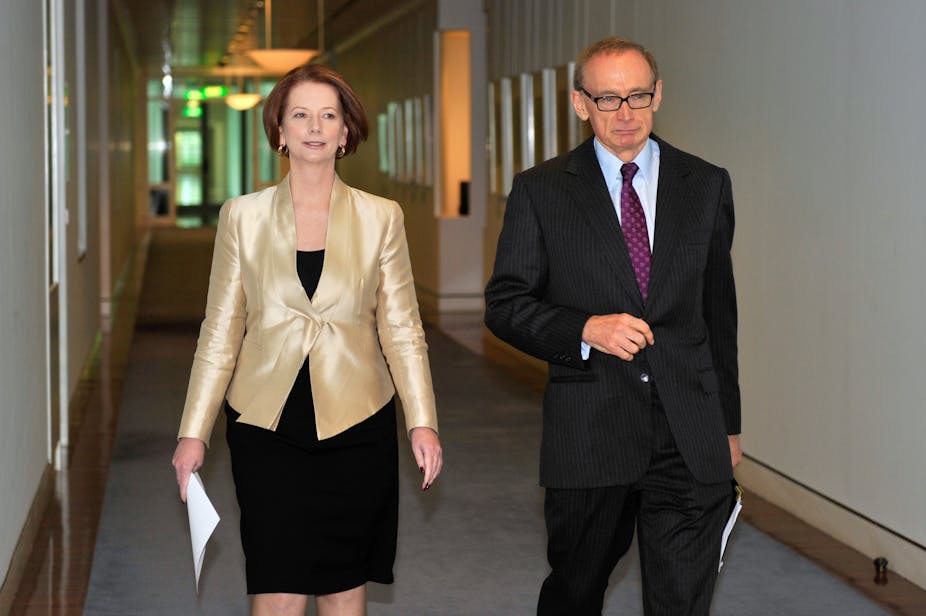Julia Gillard has successfully installed former New South Wales premier Bob Carr as minister for foreign affairs.
It wasn’t an easy process. Gillard seemed to battle both her parliamentary colleagues and the media this week over offering Carr the job.
If the government’s message of renewal has been, to use Carr’s words, difficult to “untangle”, the cabinet reshuffle nonetheless has given Gillard the opportunity to revamp her communication strategy.
The credibility challenge
Gillard’s communications director, John McTernan, probably hasn’t been fazed by the remarkable challenges of the past few weeks, especially after his experiences in the United Kingdom with Tony Blair. Still, he must be wondering what the Federal Government has to do to convince voters it is worth re-electing.
He won’t be alone.
The ALP’s National Secretariat, which will run the 2013 election campaign, will have a similar focus. But McTernan’s task is urgent, more difficult, may be intractable, and he’s running out of time. If he gets his communication strategy right, the election campaign will be easier; if his strategy falls over, disaster ensues.
Today’s cabinet re-shuffle might provide a fresh start, but McTernan’s communication challenge remains how he deals with two polar issues: the Prime Minister’s credibility with voters (negative according to the polls) and the Government’s legislative success and achievements (positive by all accounts).
Cutting the knot
From a communication strategy perspective, this contradiction is a Gordian Knot tightly constricting the government’s ability to speak over the negative clatter in the mass news media with positive messages. Cut the knot and the path may be clear.
Communication strategy is about the long game and it takes time to work. Unfortunately, the default position for Australian political communication is too often that it must be done through the mass news media with a single daily message.
That is cheap, generates instant coverage, and allegedly reaches a lot of people, especially the party faithful, and involves an old theory – the rule of threes. This holds, briefly, that if a message is delivered three times, in three places, in three different ways it has a better chance of being understood. Thus, the idea that Gillard lied about the talking to Bob Carr, can’t be trusted, and has no credibility, has been repeated at the fish shop, furniture factory and in the House of Representatives this week.
There are signs the PM’s undoubted debating abilities are being used to combat this, if her assertive question time performances this week, and steely performance at the announcement of the cabinet today, are a guide.
At last there seems to at least be some plain, direct speaking. Maybe Bob Carr was correct when he said at today’s cabinet announcement, “In the end, it is the leader who cuts through”. But what about the long game?
Beyond the baby-kiss
Political commentators argue Gillard’s government lacks a grand narrative, the story it needs to tell about what it believes in and what it is doing.
It goes without saying that the strategic goal for all political parties is to win the election. Everything that follows – from hard hats, baby kissing, and extravagant language to claim and counter-claim, incessant media releases, door-stop interviews, and over-blown Parliamentary rhetoric – is designed to promote a narrative to achieve that goal.
But none of that is real communication, which involves working out how to actually reach people with messages.
Voters are not identikit Australians. They have, for example, different interests, problems, values, and ways of accessing information. Not everyone watches the nightly TV news, reads the morning papers, uses a computer, or listens to radio shock jocks.
Communicating with them means the apparatchiks who advise politicians need to identify which voters they need to address on specific issues, how those voters might best be reached, what they should actually say in what format, and when. That’s a difficult, time-consuming and often costly exercise but it works in the long-term.
Boots on the ground
One way McTernan can approach this is to use the PM’s undoubted strength as a personal communicator. She needs to meet as many Australians as possible, on their home turf, to explain the government’s narrative.
The strategic communication point is that getting a consistent message to voters involves more than defeating the daily flack. It means hard, long-term thinking especially about how people receive and process meaningful messages about policy and achievements.
McTernan and the new cabinet may yet have just enough time to do that, but they should not expect the Opposition’s flack to end.

